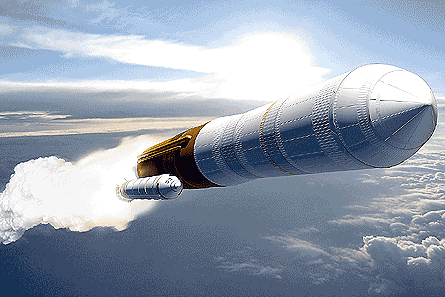NASA has detailed its plans to spend at least $68 million until 2013 on the development of the largest rocket ever, its proposed Ares V cargo launch vehicle (CaLV) that will send the USA back to the Moon by 2020.
Taller and more powerful than the Apollo programme's Saturn V launcher, with a gross lift-off mass of just over 3.7 million kg (8.17 million lb), the 116m (360ft)-high rocket is limited by NASA's Kennedy Space Center vehicle assembly building's height.
Unveiled as the cargo launch vehicle (CaLV) in 2005 and renamed Ares V in 2006, it has two two solid rocket boosters (SRB) for its first-stage and a core stage that uses six Pratt & Whitney Rocketdyne 797,000lb (3,500kN)-thrust (108% in vacuum) RS-68B engines. Its upper, Earth Departure Stage (EDS) uses the PW&R 294,000lb (1,308kN)-thrust J-2X, derived from Saturn V’s second-stage J-2 and under development for the Ares I crew launch vehicle’s (CLV) upper stage.
Launched 90min after Ares I, the CaLV's mission is to put the 45,000kg Altair Lunar Lander into a 242km (150miles) orbit at a 29° inclination, using its EDS, which has a mass of 101,900kg after its ascent burn.
|
|---|
Above: NASA's Ares V cargo launch vehicle's test flight is in June 2018 |
Ares V is to have a loss-of-mission probability of no greater than one in 125. But, because it conducts the crewed Altair, Orion crew exploration vehicle (CEV) stack's trans-lunar injection (TLI) burn, the EDS is to have a loss-of-crew probability of "no greater than one in 37,000".
With its only test flight planned for June 2018, NASA is using the 51.00.48 point of departure (POD) design approved at its Lunar Concept Capability Review (LCCR) in June, as the basis for its design, development, test and evaluation work (DDT&E).
With that 2018 test, the two-phase Ares V DDT&E procurement process should see contracts awarded for phase one by the third quarter of 2009. This phase sees industry support NASA's design process.
Phase two is about completion of the DDT&E and placing of the production contract. Phase two's contracts will be awarded in the first quarter of 2012, with the system definition review (SDR) in March. As with the CLV, NASA will own the design and vehicle integration.
The subject of those phases, the LCCR POD design, can deliver a 71,100kg TLI payload, which is the Altair, the 20,200kg Orion and a performance margin of 5,900kg.
But this is not enough. NASA's pre-phase report says: "The Ares V vehicle needs substantially more impulse during the atmospheric phase of flight than the core stage and the...[first-stage] can provide."
The performance margin target is 9,800kg, requiring a TLI payload capability of 75,000kg. But the payload for cargo-only missions is just the 53,600kg uncrewed Altair. To gain that additional 3,900kg for crewed missions NASA can enhance its first-stage solid rocket booster (SRB) motor performance.
Phase one will investigate an "improved SRB", but existing proposals include removing the first-stage's recovery systems, which increases payload capability by 4,400kg, but makes the SRBs expendable; or using filament-wound segment casings containing the fuel hydroxy-terminated polybutadiene (HTPB) to achieve the 9,800kg margin.
Because the first stage has 5.5-segment solid rocket motors, NASA has decided it requires three static firing requalification tests. They would take place around 2016-17. The agency is also investigating, separately, electromechanical actuators for SRB thrust vector control. It is not clear what mass saving that might deliver.
To decide what changes should be adopted, NASA will spend the $68 million, and more, next year and through 2010, 2011 and 2012. For phase one's firm fixed- price contracts, the EDS and core are worth $20.55 million each, the first-stage SRB is worth $13.7 million and the avionics and the shroud get $6.85 million each. The shroud is a 9,400kg cork-covered aluminium honeycomb quad petal design that may become a bullet-like shape.
However the J-2X and RS-68B engines are not included in the phase one. Both engines use liquid oxygen and liquid hydrogen and the J-2X achieved its critical design review (CDR) this year. It is to be tested at sea level and in altitude simulations.
With the exception of phase one's core engine layout design study, the RS-68B, with its 414s specific impulse, is being developed under a joint programme with the US Air Force. For its certification testing the target date is the first quarter of 2019, before the Ares V design certification review, and six engines will be used.
Now, NASA's plan is for Ares V's first design analysis cycle to last from July 2011 to the SDR with the preliminary design review (PDR) starting in late 2013 and the CDR in 2016.
For testing hardware, the notional schedule sees the core and EDS main propulsion test articles fabricated after the rocket's PDR that is to finish by the second quarter of 2014.
The EDS and core integrated ground vibration testing is to take place from the third quarter of 2015 until the fourth quarter of 2016. Both are built at NASA's Michoud Assembly Facility, near New Orleans, and the engines are integrated with the stages there.
The stages' propellants tanks are aluminium lithium alloy 2195 and their skirts and interstage will be the graphite expoy IM7. Ares V may use avionics that are common with its sister vehicles, the CLV, Altair and CEV.
NASA recognises that Ares V's testing requirements could mean investment in new facilities, and that future budget challenge will not be the first hurdle.
Assuming the CaLV survives whatever changes president-elect Barack Obama's administration brings, while technical hitches may change target dates, Ares V's successful completion will see the world's largest ever rocket launch a new era of space exploration.
Source: Flight International



























